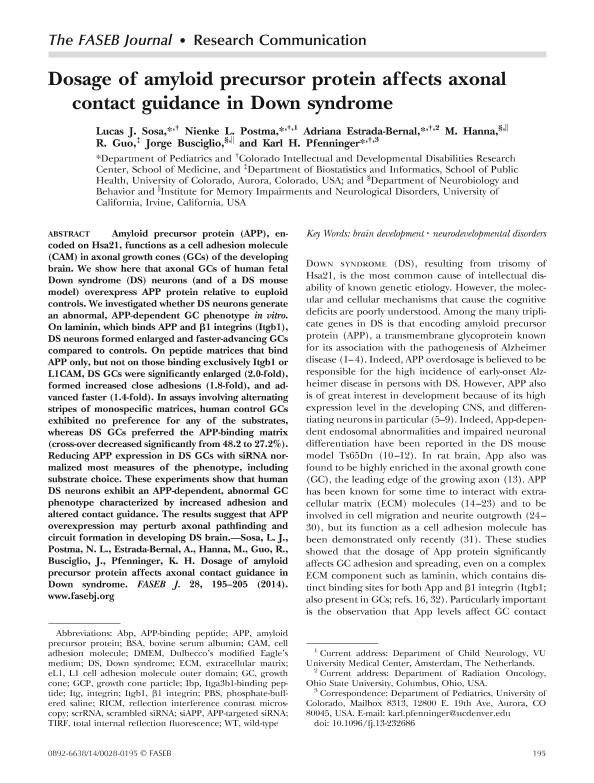Mostrar el registro sencillo del ítem
dc.contributor.author
Sosa, Lucas Javier

dc.contributor.author
Postma, Nienke L.
dc.contributor.author
Estrada-Bernal, Adriana
dc.contributor.author
Hanna, M.
dc.contributor.author
Guo, R.
dc.contributor.author
Busciglio, Jorge

dc.contributor.author
Pfenninger, Karl H.
dc.date.available
2021-04-20T19:24:50Z
dc.date.issued
2014-01
dc.identifier.citation
Sosa, Lucas Javier; Postma, Nienke L.; Estrada-Bernal, Adriana; Hanna, M.; Guo, R.; et al.; Dosage of amyloid precursor protein affects axonal contact guidance in Down syndrome; Federation of American Societies for Experimental Biology; FASEB Journal; 28; 1; 1-2014; 195-205
dc.identifier.issn
0892-6638
dc.identifier.uri
http://hdl.handle.net/11336/130547
dc.description.abstract
Amyloid precursor protein (APP), encoded on Hsa21, functions as a cell adhesion molecule (CAM) in axonal growth cones (GCs) of the developing brain. We show here that axonal GCs of human fetal Down syndrome (DS) neurons (and of a DS mouse model) overexpress APP protein relative to euploid controls. We investigated whether DS neurons generate an abnormal, APP-dependent GC phenotype in vitro. On laminin, which binds APP and 1 integrins (Itgb1), DS neurons formed enlarged and faster-advancing GCs compared to controls. On peptide matrices that bind APP only, but not on those binding exclusively Itgb1 or L1CAM, DS GCs were significantly enlarged (2.0-fold), formed increased close adhesions (1.8-fold), and advanced faster (1.4-fold). In assays involving alternating stripes of monospecific matrices, human control GCs exhibited no preference for any of the substrates, whereas DS GCs preferred the APP-binding matrix (cross-over decreased significantly from 48.2 to 27.2%). Reducing APP expression in DS GCs with siRNA normalized most measures of the phenotype, including substrate choice. These experiments show that human DS neurons exhibit an APP-dependent, abnormal GC phenotype characterized by increased adhesion and altered contact guidance. The results suggest that APP overexpression may perturb axonal pathfinding and circuit formation in developing DS brain.
dc.format
application/pdf
dc.language.iso
eng
dc.publisher
Federation of American Societies for Experimental Biology

dc.rights
info:eu-repo/semantics/openAccess
dc.rights.uri
https://creativecommons.org/licenses/by-nc-sa/2.5/ar/
dc.subject
BRAIN DEVELOPMENT
dc.subject
NEURODEVELOPMENTAL DISORDERS
dc.subject.classification
Neurociencias

dc.subject.classification
Medicina Básica

dc.subject.classification
CIENCIAS MÉDICAS Y DE LA SALUD

dc.title
Dosage of amyloid precursor protein affects axonal contact guidance in Down syndrome
dc.type
info:eu-repo/semantics/article
dc.type
info:ar-repo/semantics/artículo
dc.type
info:eu-repo/semantics/publishedVersion
dc.date.updated
2021-03-26T19:37:47Z
dc.identifier.eissn
1530-6860
dc.journal.volume
28
dc.journal.number
1
dc.journal.pagination
195-205
dc.journal.pais
Estados Unidos

dc.journal.ciudad
Bethesda
dc.description.fil
Fil: Sosa, Lucas Javier. University Of Colorado Anschutz Medical Center, Aurora; Estados Unidos
dc.description.fil
Fil: Postma, Nienke L.. School of Medicine, Aurora; Estados Unidos
dc.description.fil
Fil: Estrada-Bernal, Adriana. School of Medicine, Aurora; Estados Unidos. University Of Colorado Anschutz Medical Center, Aurora; Estados Unidos
dc.description.fil
Fil: Hanna, M.. University of California at Irvine; Estados Unidos
dc.description.fil
Fil: Guo, R.. University of Colorado; Estados Unidos
dc.description.fil
Fil: Busciglio, Jorge. University of California at Irvine; Estados Unidos
dc.description.fil
Fil: Pfenninger, Karl H.. University Of Colorado Anschutz Medical Center, Aurora; Estados Unidos
dc.journal.title
FASEB Journal

dc.relation.alternativeid
info:eu-repo/semantics/altIdentifier/url/https://faseb.onlinelibrary.wiley.com/doi/10.1096/fj.13-232686
dc.relation.alternativeid
info:eu-repo/semantics/altIdentifier/doi/http://dx.doi.org/10.1096/fj.13-232686
Archivos asociados
